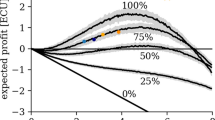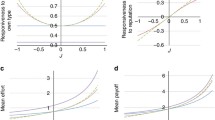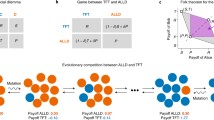Abstract
We model the formation of friendships as repeated cooperation within a set of heterogeneous players. The model is built around three of the most important facts about friendship: friends help each other, there is reciprocity in the relationship and people usually have only a few friends. In our results, we explain how similarity between people affects the friendship selection. We also characterize the long-run friendship network and illustrate how friendships emerge given the random process by which people meet each other.
Similar content being viewed by others
References
Axelrod R (1984) The evolution of cooperation. Basic Books, New York
Bala V, Goyal S (2000) A noncooperative model of network formation. Econometrica 68(5): 1181–1229
Borgatti SP (2002) NetDraw: graph visualization software. Analytic Technologies, Harvard
Buunk BP, Prins KS (1998) Loneliness, exchange orientation, and reciprocity in friendships. Pers Relationsh 5: 1–14
Cloninger CR (1986) A unified biosocial theory of personality and its role in the development of anxiety states. Psychiatr Dev 3: 167–226
Currarini S, Jackson MO, Pin P (2009) An economic model of friendship: homophily, minorities and segregation. Econometrica (forthcoming)
de Vos H, Zeggelink E (1997) Reciprocal altruism in human social evolution: the viability of reciprocal altruism with preference for old-helping-partners. Evol Hum Behav 18: 261–278
Goyal S, Vega-Redondo F (2005) Network formation and social coordination. Games Econ Behav 50: 178–207
Hallinan MT (1978/79) The process of friendship formation. Social Netw 1(2): 103–210
Hruschka DJ, Henrich J (2004) The evolution of friendship. mimeo
Jackson MO, Rogers BW (2007) Meeting strangers and friends of friends: how random are social networks? Am Econ Rev 97(3):890–915
Jackson MO, Wolinsky A (1996) A strategic model of social and economic networks. J Econ Theory 71: 44–74
Lippert S, Spagnolo G (2005) Networks of relations and social capital. mimeo
Marmaros D, Sacerdote B (2004) How do friendships form? mimeo
Silk JB (2003) Cooperation without counting, the puzzle of friendship. Genetic and cultural evolution of cooperation. MIT Press, Cambridge, pp 37–54
van de Bunt GG, van de Duijn MAJ, Snijders TAB (1999) Friendship networks through time—an actor-oriented dynamic statistical network model. Comput Math Organ Theory 5(2): 167–192
Walker K (1995) Always there for me: friendship and expectations among middle- and working class men and women. Sociol Forum 10(2): 273–296
Whitmeyer JM, Yeingst CN (2006) A dynamic model of friendly association networks. Soc Sci Res 35(3): 642–667
Zeggelink EPH (1995) Evolving friendship networks: an individual-oriented approach implementing similarity. Social Netw 17: 83–110
Author information
Authors and Affiliations
Corresponding author
Additional information
Many thanks to Itai Agur, Pascal Courty, Ilan Eshel, Anna Orlik, Karl Schlag, Sanne Zwart, two anonymous referees, the associate editor and the editor for very useful comments and discussions. I also thank the seminar participants at the European University Institute and University of Wisconsin-Madison.
Rights and permissions
About this article
Cite this article
Rivas, J. Friendship selection. Int J Game Theory 38, 521–538 (2009). https://doi.org/10.1007/s00182-009-0168-3
Accepted:
Published:
Issue Date:
DOI: https://doi.org/10.1007/s00182-009-0168-3




